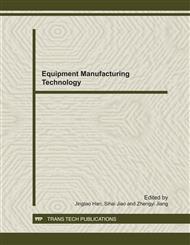[1]
L. Järup. Hazards of heavy metal contamination. British Medical Bulletin, 2003, 68: 167~182.
DOI: 10.1093/bmb/ldg032
Google Scholar
[2]
D. Zhang, YL. Zheng, Y. Luo. Analysis of Heavy Metals in Some Wild Edible Mushroomsfrom Mountains in Sichuan and Yunan.Journal of Mountain Science, 2004, 22 (6) 767~771.In Chinese
Google Scholar
[3]
GB. Zhou. Discussion on the Categories and Distribution of Bolete in Liangshan Subtropical Zone. Journal of Xichang College·Natural Science Edition, 2008, 22 (2).In Chinese
Google Scholar
[4]
H. Yang. Wild Mushroom Resources and Its Sustainable Utilization in Liangshan Area. Resource Development &Market, 2004, 20 (2).In Chinese
Google Scholar
[5]
TH. Li, B. Song. Acta Species and Distributions of Chinese Edible Boletes. Edulis Fungi, 2002, 9 (2) 22~30.In Chinese
Google Scholar
[6]
CY. Huang, Q. Chen, YC. Chao, JX. Zhang. Investigation on Heavy Metals of Main Wild Edible Mushrooms in Yunnan Province. Scientia Agricultura Sinica, 2010, 43(6) 1207~1212.In Chinese
Google Scholar
[7]
MS. Yuan , PQ. Sun. Sichuan Mushroom.Cheng du:Sichuan Science and Technology Press(1995) 239~302. In Chinses
Google Scholar
[8]
(GB/T 5009.15-2003)(Determination of cadmium in foods)[s].
Google Scholar
[9]
(GB/T 5009.12-2003)(Determination of lead in foods)[s].
Google Scholar
[10]
(GB/T5009.14-2003)(Determination of zinc in foods)[s].
Google Scholar
[11]
(GB/T5009.13-2003)(Determination of copper in foods)[s].
Google Scholar
[12]
(GB/T5009.17-2003)(Determination of mercury in foods)[s].
Google Scholar
[13]
R. Seeger, E. Meyer, S. Scho¨nut. (1976). Blei in Pilzen. Z. Lebensm Unters-Forsch., 162, 7~10.
DOI: 10.1007/bf01104354
Google Scholar
[14]
D. Ayhan, Concentrations of 21 metals in 18 species of mushrooms growing in the East Black Sea region[J]. Food Chemistry, 2001, (75) 453~457.
DOI: 10.1016/s0308-8146(01)00236-9
Google Scholar
[15]
L. Svoboda, K. Zimmermannov. P. Kala. Concentrations of mercury, cadmium,lead and copper in fruiting bodies of edible mushrooms in an emission area of a copper smelter and a mercury smelter. The Science of the Total Environment, 246 (2000.) 61~67.
DOI: 10.1016/s0048-9697(99)00411-8
Google Scholar
[16]
R. Maria, L. Tomasz. Trace elements in fruiting bodies of ectomycorrhizal fungi growing in Scots pine (Pinus sylvestris L.) stands in Poland. Science of the Total Environment 339 (2005) 103~115.
DOI: 10.1016/j.scitotenv.2004.08.002
Google Scholar
[17]
A. Andersen, S. E. Lykke, M. Lange, et al. Trace elements in edible mushrooms[M]. National Food Institute, Publ. 68 , Stat . Levnedsmiddelinst . ,Den-mark, 1982. 29.
Google Scholar
[18]
P. kalac , J.Burda, I.Stas Ková. Concentration of Lead,Cadium,Mercury and Copper in mushrooms in the Vicinity of a lead smelter [ J ]. The Science of The Total Environment, 1991, 105 (6) 109~119.
DOI: 10.1016/0048-9697(91)90333-a
Google Scholar
[19]
D. Zhang, F. Aneta, J. Falandysz. Metals of King Bolete(Boletus edulis)Bull .: Fr . collected at the same site over two years. African Journal of Agricultural Research 2010, 5 (22), pp.3050-3055.
Google Scholar
[20]
G. Tyler. Metals in sporophores of basidiomycetes. Trans Br MycolSoc 1980. (74) 41~ 9.
Google Scholar


